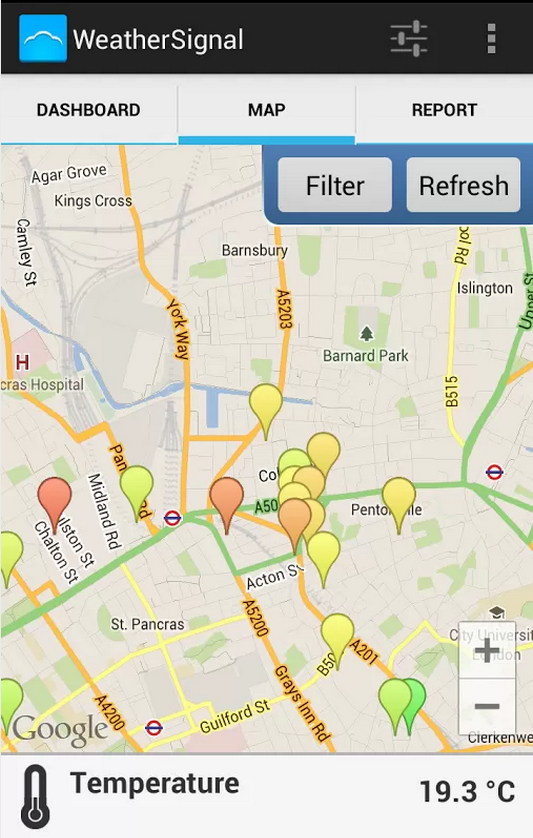Smartphones As Weather Surveillance Systems
You probably never think about the temperature of your smartphone’s battery, but it turns out to provide an interesting method for tracking outdoor air temperature. It’s a discovery that adds to other evidence that mobile apps could provide a new way to measure what’s happening in the atmosphere and improve weather forecasting.

Startup OpenSignal, whose app crowdsources data on cellphone reception, first noticed in 2012 that changes in battery temperature correlated with those outdoors. On Tuesday, they published a scientific paper on that technique in a geophysics journal and announced that the technique will be used to interpret data from a weather crowdsourcing app. OpenSignal originally started collecting data on battery temperatures to try and understand the connections between signal strength and how quickly a device chews through its battery.
OpenSignal’s crowdsourced weather-tracking effort joins another accidentally enabled by smartphones. A project called PressureNET that collects air pressure data by taking advantage of the fact many Android phones have a barometer inside to aid their GPS function (see “App Feeds Scientists Atmospheric Data From Thousands of Smartphones”). Cliff Mass, an atmospheric scientist at the University of Washington, is working to incorporate PressureNET data into weather models that usually rely on data from weather stations. He believes that smartphones could provide valuable data from places where there are no weather stations, if enough people start sharing data using apps like PressureNET.
Other research suggests that logging changes in cell network signal strength perceived by smartphones could provide yet more weather data. In February researchers in the Netherlands produced detailed maps of rainfall compiled by monitoring fluctuations in the signal strength measured by cellular network masts, caused by water droplets in the atmosphere.
So far, neither PressureNET nor WeatherSignal–which also measures pressure and light intensity in addition to the battery trick–have enough users to significantly impact the world of weather tracking and forecasting, but the potential seems to be there. Data gathered from smartphones has enabled Google and others to track traffic and congestion more accurately than ever before (see “Android Helps Google Grow Its Traffic Surveillance System”). It’s possible to imagine weather getting a similar treatment.
Keep Reading
Most Popular
Large language models can do jaw-dropping things. But nobody knows exactly why.
And that's a problem. Figuring it out is one of the biggest scientific puzzles of our time and a crucial step towards controlling more powerful future models.
How scientists traced a mysterious covid case back to six toilets
When wastewater surveillance turns into a hunt for a single infected individual, the ethics get tricky.
The problem with plug-in hybrids? Their drivers.
Plug-in hybrids are often sold as a transition to EVs, but new data from Europe shows we’re still underestimating the emissions they produce.
Stay connected
Get the latest updates from
MIT Technology Review
Discover special offers, top stories, upcoming events, and more.